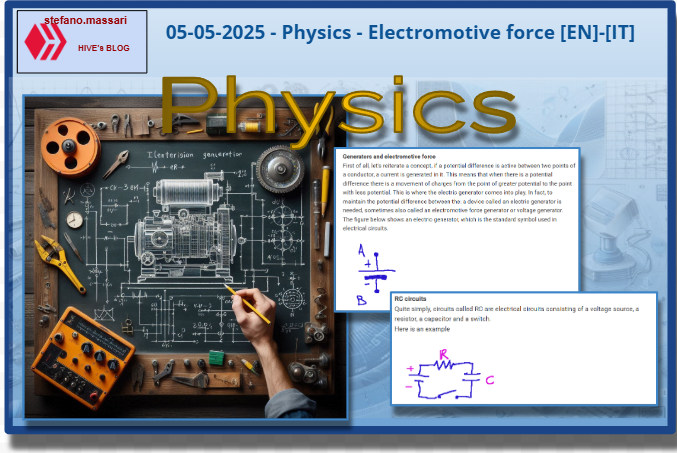
~~~ La versione in italiano inizia subito dopo la versione in inglese ~~~
ENGLISH

05-05-2025 - Physics - Electromotive force [EN]-[IT]
With this post I would like to give a brief instruction on the topic mentioned in the subject
(code notes: X_35-34-33)
Electromotive force

image created with artificial intelligence, the software used is Microsoft Copilot
Generators and electromotive force
First of all, let's reiterate a concept, if a potential difference is active between two points of a conductor, a current is generated in it. This means that when there is a potential difference there is a movement of charges from the point of greater potential to the point with less potential. This is where the electric generator comes into play. In fact, to maintain the potential difference between the: a device called an electric generator is needed, sometimes also called an electromotive force generator or voltage generator.
The figure below shows an electric generator, which is the standard symbol used in electrical circuits.

The electromotive force is a quantity that measures the ability of an electrical source to generate an electric current. It can be a battery or a generator.
The electromotive force is measured in Volts and depends on the internal mechanisms of the source. For example, there are batteries that can generate 1.5 V, others 3 V, others 12 V, etc. etc.
In technical terms, the electromotive force of a generator is the line integral of the electromotive field along a path inside the generator that goes from the negative terminal to the positive terminal.
Below is the mathematical expression of what was said above.
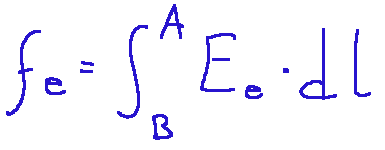
The electromotive force is for an electrical circuit what a water pump is for a hydraulic circuit. The water pump creates a flow of water inside a hydraulic circuit, while the electromotive force creates a flow of charges inside an electrical circuit.
Generator power
What is the power of a generator? Since the generator allows to activate a flow of electric charges, it will certainly have the capacity to generate this flow with more or less power. The power of a generator is measured in watts (W).
The power depends on the potential difference that the generator produces and the flow of electrons that the generator supplies to the circuit.
The formula for electrical power is shown below:
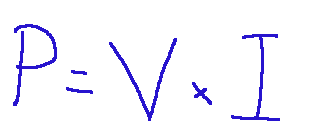
Where:
P = Power in watts
V = Voltage in volts
I = Current in amperes.
Example:
If a generator is capable of supplying a voltage of 12V and a current of 5 amperes, then it will have a power of 60W
Kirchhoff's laws
Kirchhoff's laws are fundamental criteria in electrical engineering.
The first law is called the law of currents. This states that the sum of the currents entering a node is equal to the sum of the currents leaving the node. This law is as if it were to establish a fundamental principle of electrical engineering, that is, that electric current is conserved.
The second law, on the other hand, is called the law of voltages. This states that the algebraic sum of the voltages in a closed circuit is always equal to zero. This law expresses the concept that in a closed circuit the total energy supplied by the electrical sources is completely distributed between the resistors and the other electrical components.
NOTE: Kirchhoff (1824-1887) was a German physicist known above all for his fundamental contributions to electrical engineering, but he also worked in spectroscopy and thermodynamics.
Thevenin's Theorem
In electrical engineering there are some fundamental steps to go through when starting an educational path. Ohm's law and Kirchhoff's two laws are certainly part of the beginning of this path, but it doesn't end there. The conclusions of a good basic education on electrical engineering must also include Thevenin's Theorem.
Thevenin's Theorem is a fundamental principle of electrical engineering and is used to simplify the analysis of electrical circuits considered complex. This theorem states that any linear circuit composed of voltage generators, or current generators, and resistances can be replaced by an equivalent circuit. This equivalent circuit is formed by an equivalent voltage source, an equivalent resistance, with the load connected to the original circuit.
Below is an example of a simple circuit and its configuration in the Thevenin equivalent circuit.
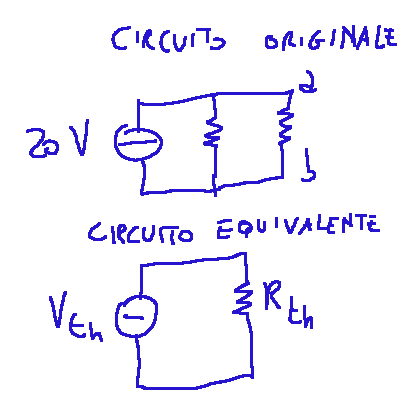
RC circuits
Quite simply, circuits called RC are electrical circuits consisting of a voltage source, a resistor, a capacitor and a switch.
Here is an example
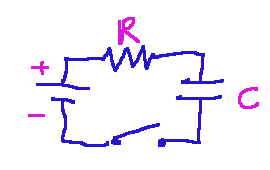
These circuits are used to filter signals, create timers, charge and discharge capacitors, perform sampling and perform analog-to-digital conversions
The conservation of energy
One of the fundamental laws in electrical engineering is precisely the principle of conservation of energy.
This principle states that the total energy in an isolated electrical system is conserved. This energy cannot be created or destroyed, but can only be transformed from one form to another.
It is difficult to attribute the formulation of this principle to just one person, but we can say that the first to study this thing and understand it were, Émilie du Châtelet, Julius Robert Mayer, James Prescott Joule, Hermann von Helmholtz.
Historically we know that the principle was formally enunciated by Mayer, Joule and Helmholtz in 1800.
Conclusions
The electromotive force represents the ability to create a current inside a circuit. The electromotive force is found in many applications such as batteries, accumulators, electric generators, solar panels, electric cars, sensors and electronic instrumentation.
Question
Did you know that Kirchhoff formulated the laws of electric circuits in 1845 and that they are still fundamental today for the analysis of circuits? Did you know that in school when we talk about the electrical engineering of circuits we still start from his laws formulated 180 years ago?

ITALIAN

05-05-2025 - Fisica - La forza elettromotrice [EN]-[IT]
Con questo post vorrei dare una breve istruzione a riguardo dell’argomento citato in oggetto
(code notes: X_35-34-33)
La forza elettromotrice

immagine creata con l’intelligenza artificiale, il software usato è Microsoft Copilot
Generatori e forza elettromotrice
Innanzitutto, ribadiamo un concetto, se tra due punti di un conduttore è attiva una differenza di potenziale in esso generato una corrente. Questo significa che quando è presente una differenza di potenziale esiste un moto di cariche dal punto di potenziale maggiore a quella con potenziale minore. È qui che entra in gioco il generatore elettrico.infatti, per mantenere la differenza di potenziale tra i: è necessario un dispositivo che viene chiamato generatore elettrico, talvolta anche chiamato generatore di forza elettromotrice o generatore di tensione.
Nella figura qui di seguito è schematizzato un generatore elettrico, ovvero il simbolo standard usato nei circuiti elettrici.

La forza elettromotrice invece è una grandezza che misura la capacità di una sorgente elettrica di generare una corrente elettrica. Essa può essere una batteria o un generatore.
La forza elettromotrice si misura in Volt e dipende dai meccanismi interni della sorgente. Ci sono ad esempio batterie che possono generare 1,5 V, altre 3 V altre 12V, ecc…ecc…
In termini tecnici la forza elettromotrice di un generatore è l’integrale di linea del campo elettromotore lungo un percorso interno al generatore che va dal morsetto negativo a quello positivo.
Qui di seguito l'espressione matematica di quanto detto sopra.

La forza elettromotrice è per un circuito elettrico quello che una pompa d’acqua è per un circuito idraulico. La pompa dell’acqua crea un flusso d’acqua all’interno di un circuito idraulico,mentre la forza elettromotrice crea un flusso di cariche all’interno di un circuito elettrico.
Potenza del generatore
Che cosa è la potenza di un generatore? Visto che il generatore permette di attivare un flusso di cariche elettriche, avrà sicuramente la capacità di generare questo flusso con più o meno potenza. La potenza di un generatore si misura in watt (W).
La potenza dipende dalla differenza di potenziale che il generatore produce e dal flusso di elettroni che il generatore fornisce al circuito.
Qui di seguito è mostrata la formula della potenza elettrica:

Dove:
P = La potenza in watt
V = La tensione in volt
I = La corrente in ampere.
Esempio:
Se un generatore è in grado di fornire una tensione di 12V ed una corrente di 5 Ampere, allora avrà una potenza di 60W
Le leggi di Kirchhoff
Le leggi di Kirchhoff rappresentano dei criteri fondamentali in elettrotecnica.
La prima legge, viene chiamata la legge delle correnti. Questa afferma che la somma delle correnti che entrano in un nodo è uguale alla somma delle correnti che escono dal nodo. Questa legge è come se andasse a sancire un principio fondamentale dell’elettrotecnica, cioè che la corrente elettrica si conserva.
La seconda legge, invece è chiamata legge delle tensioni. Questa afferma che la somma algebrica delle tensioni in un circuito chiuso è sempre uguale a zero. Questa legge esprime il concetto che in un circuito chiuso l’energia totale fornita dalle sorgenti elettriche è completamente distribuita tra le resistenze e gli altri componenti elettrici.
NOTA: Kirchhoff (1824-1887)fu un fisico tedesco noto soprattutto per i suoi contributi fondamentali per l’elettrotecnica, ma si occupò anche di spettroscopia e di termodinamica.
Teorema di Thevenin
In elettrotecnica ci sono dei passaggi fondamentali da attraversare per quanto riguarda l’inizio di un percorso educativo. Fanno parte dell’inizio di questo percorso sicuramente la legge di Ohm e le due leggi di Kirchhoff, ma non è finita qui. La conclusioni di una buona base di educazione sull’elettrotecnica deve comprendere anche il Teorema di Thevenin.
Il teorema di Thevenin è un principio fondamentale dell’elettrotecnica e viene usato per semplificare l’analisi dei circuiti elettrici ritenuti complessi. Questo teorema afferma che qualsiasi circuito lineare composto da generatori di tensione, o generatore di correnti, e resistenze può essere sostituito da un circuito equivalente. Questo circuito equivalente è formato da una sorgente di tensione equivalente, da una resistenza equivalente, con il carico collegato al circuito originale.
Qui di seguito un esempio di un circuito semplice e la sua configurazione nel circuito equivalente di Thevenin.

I circuiti RC
Molto semplicemente i circuiti chiamati RC sono circuiti elettrici costituiti da un generatore di tensione, una resistenza, un condensatore e un interruttore.
Qui di seguito un esempio

Questi circuiti vengono usati per filtrare i segnali, creare dei temporizzatori, caricare e scaricare condensatori, fare campionamenti e fare conversioni analogico-digitale
La conservazione dell’energia
Una delle leggi fondamentali in elettrotecnica è proprio il principio di conservazione dell’energia.
Questo principio afferma che l’energia totale in un sistema elettrico isolato si conserva.questa energia non può essere creata né distrutta, ma può essere solo trasformata da una forma all’altra.
Difficile attribuire ad una persona sola la formulazione di questo principio, possiamo però dire che i primi a studiare questa cosa e a comprenderla furono, Émilie du Châtelet, Julius Robert Mayer, James Prescott Joule, Hermann von Helmholtz.
Storicamente sappiamo che il principio fu formalmente enunciato da Mayer,Joule e Helmholtz nel 1800.
Conclusioni
La forza elettromotrice rappresenta la capacità di creare una corrente all'interno di un circuito. La forza elettromotrice la troviamo in tantissime applicazioni come batterie, accumulatori, generatori elettrici, pannelli solari, automobili elettrici, sensori e strumentazione elettronica.
Domanda
Lo sapevate che Kirchhoff formulò le leggi dei circuiti elettrici nel 1845 e che sono ancora oggi fondamentali per l'analisi dei circuiti? Lo sapevate che a scuola quando si parla di elettrotecnica dei circuiti si parte ancora oggi dalle sue leggi formulate 180 anni fa?
THE END




